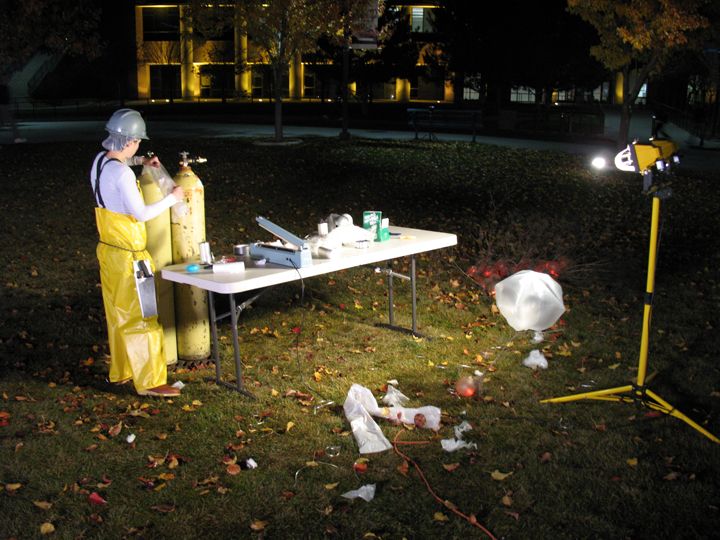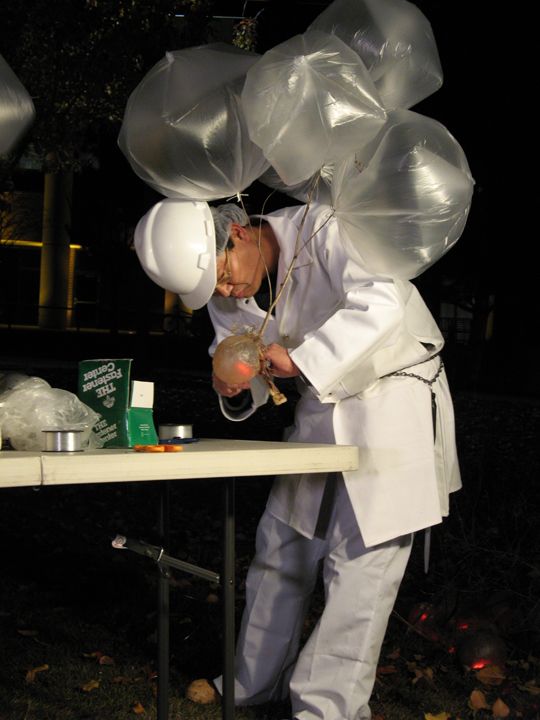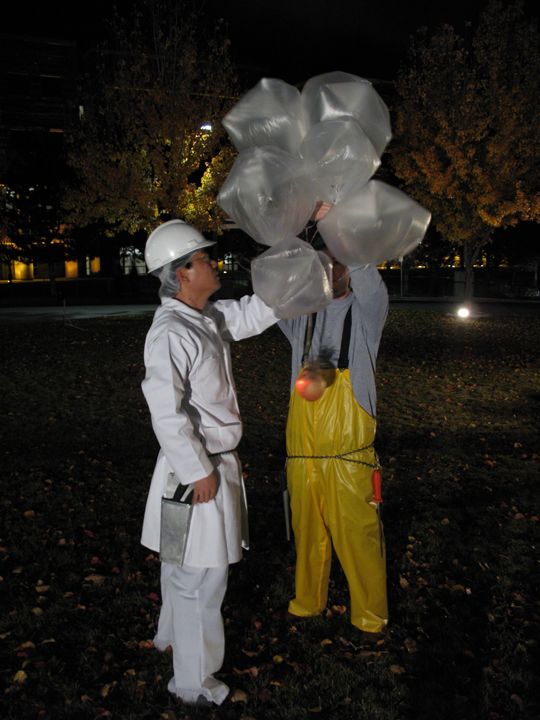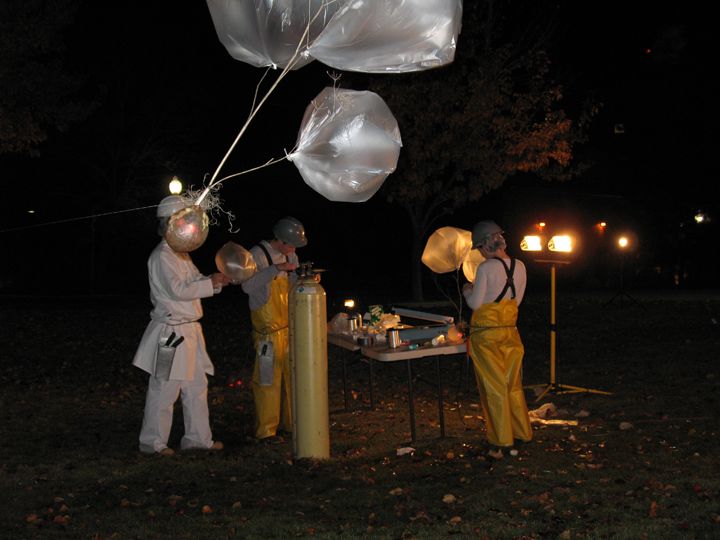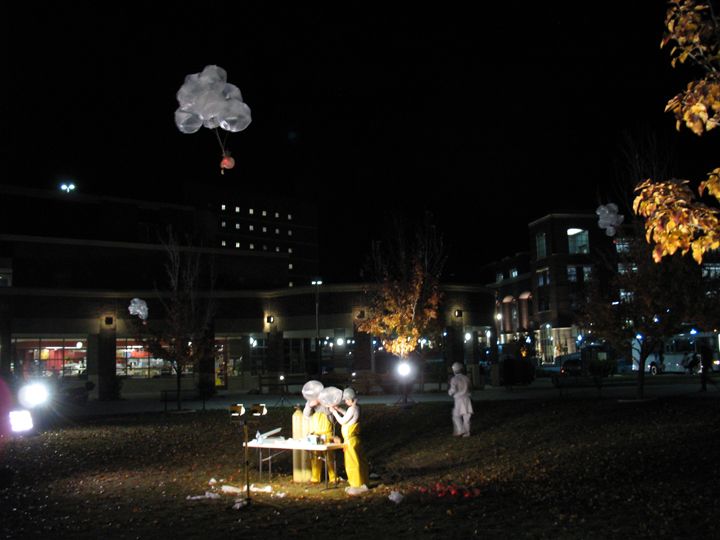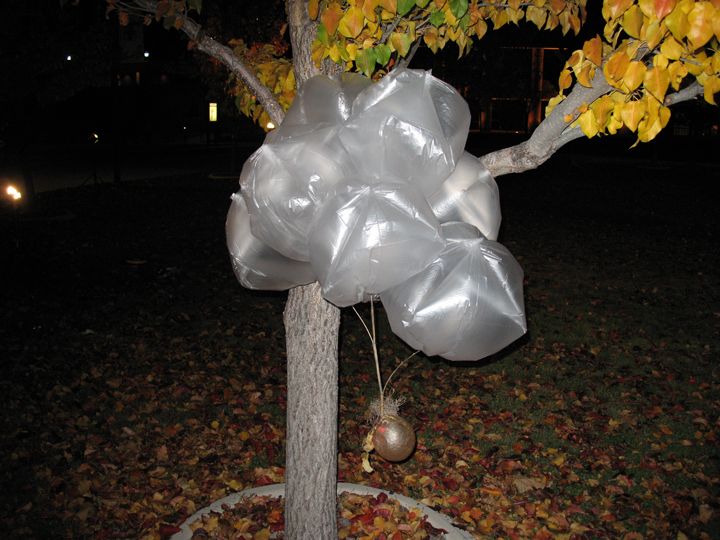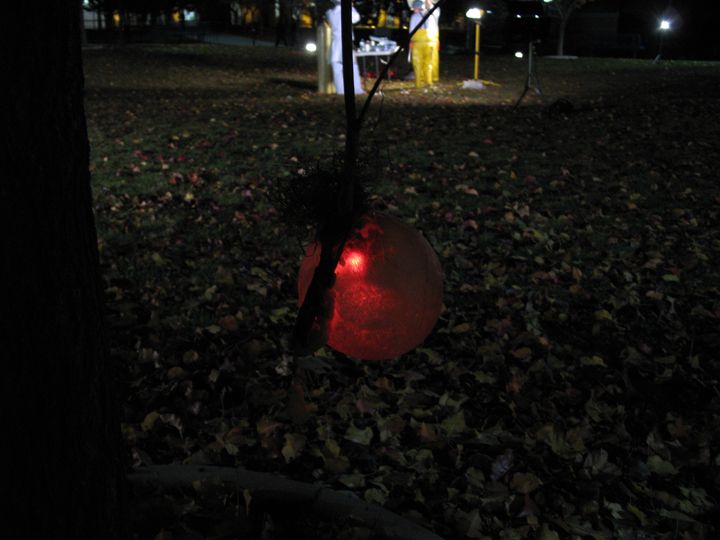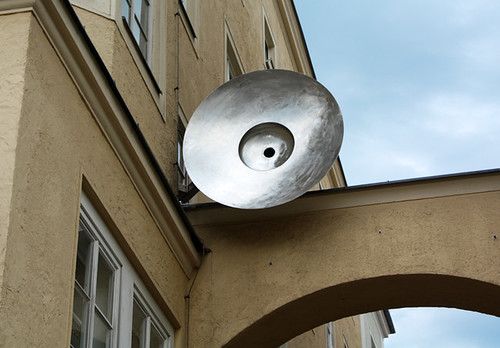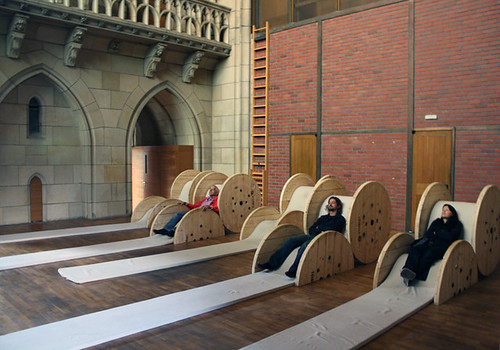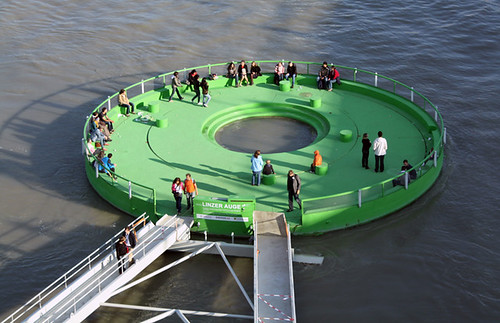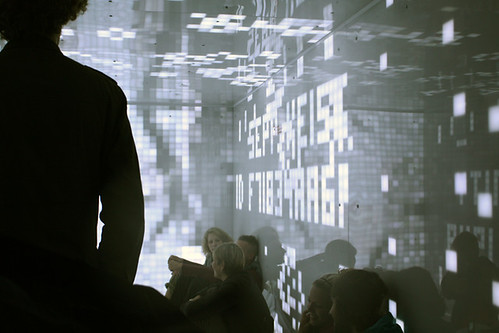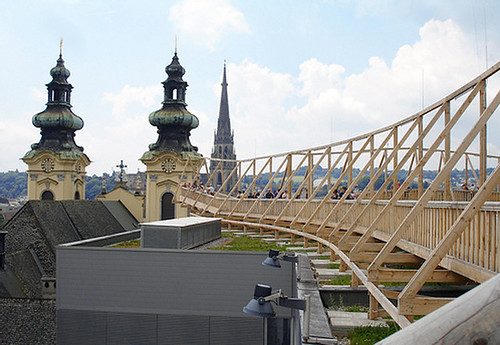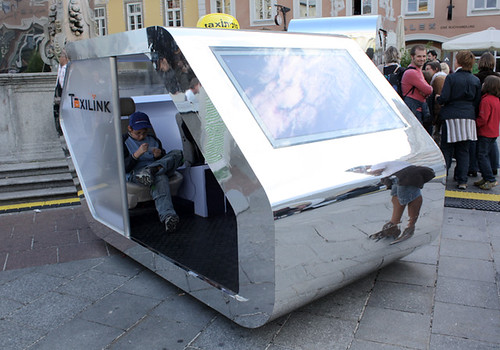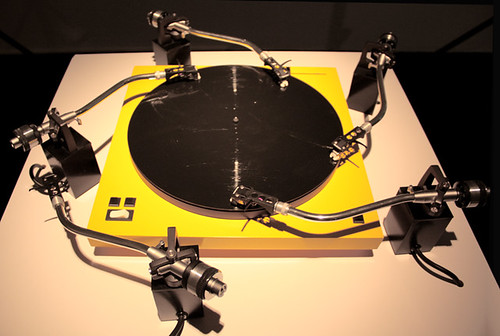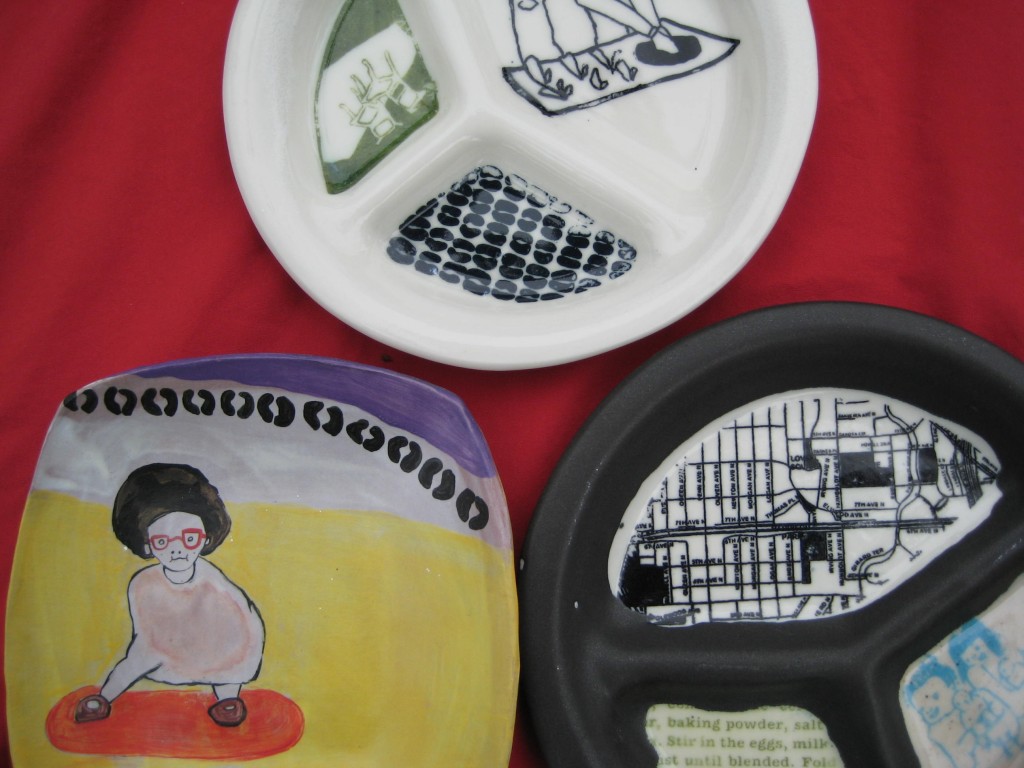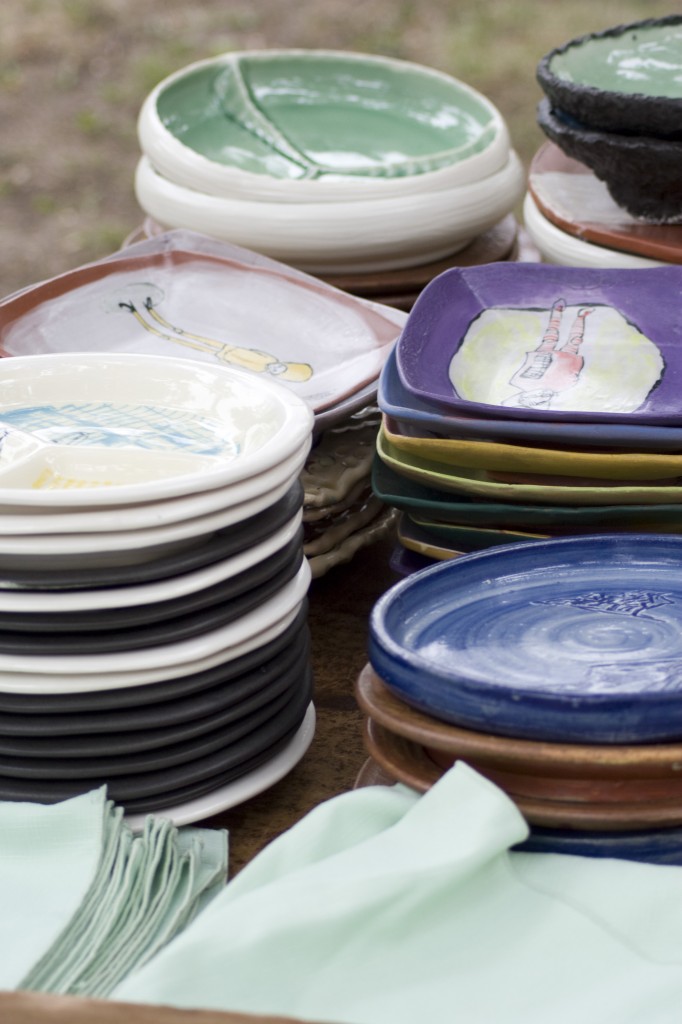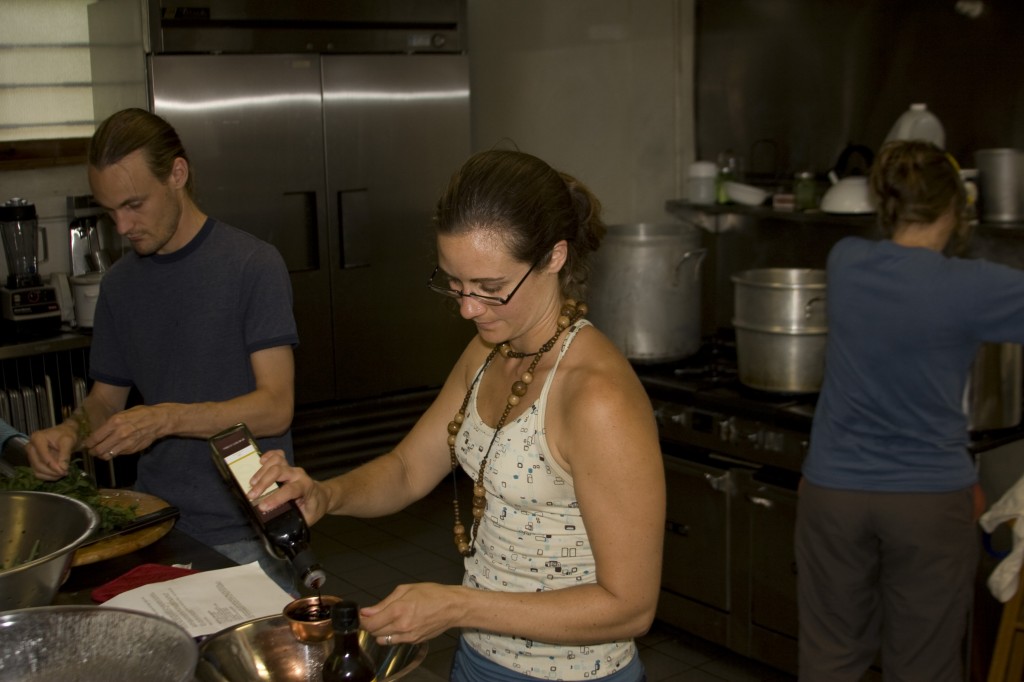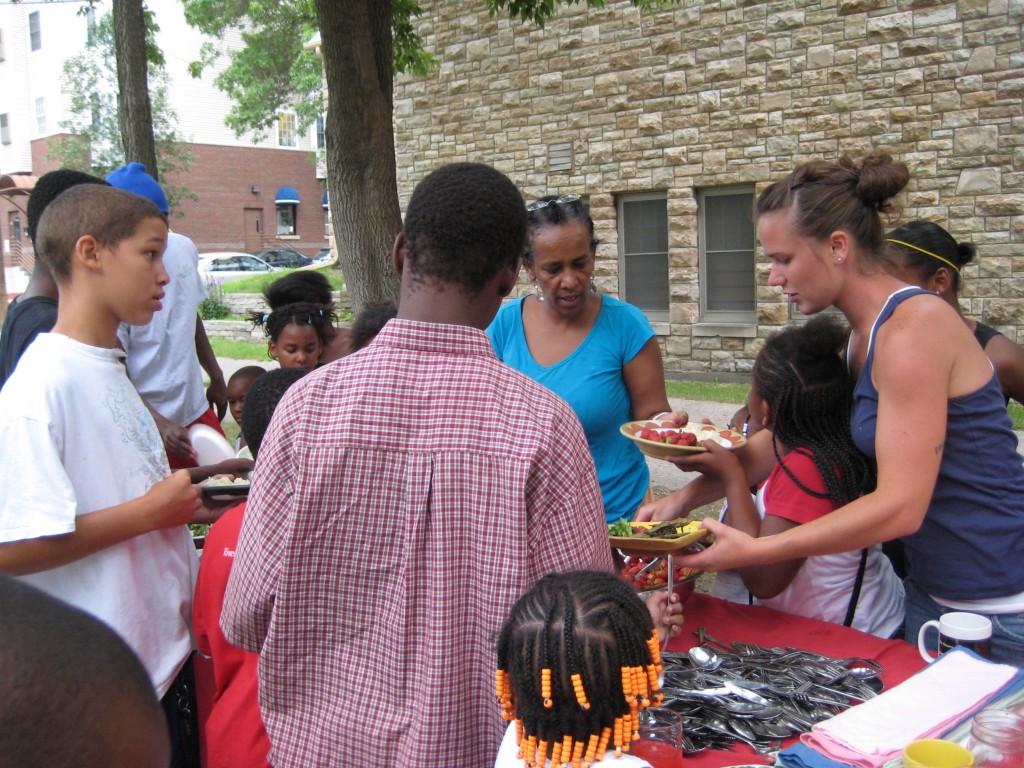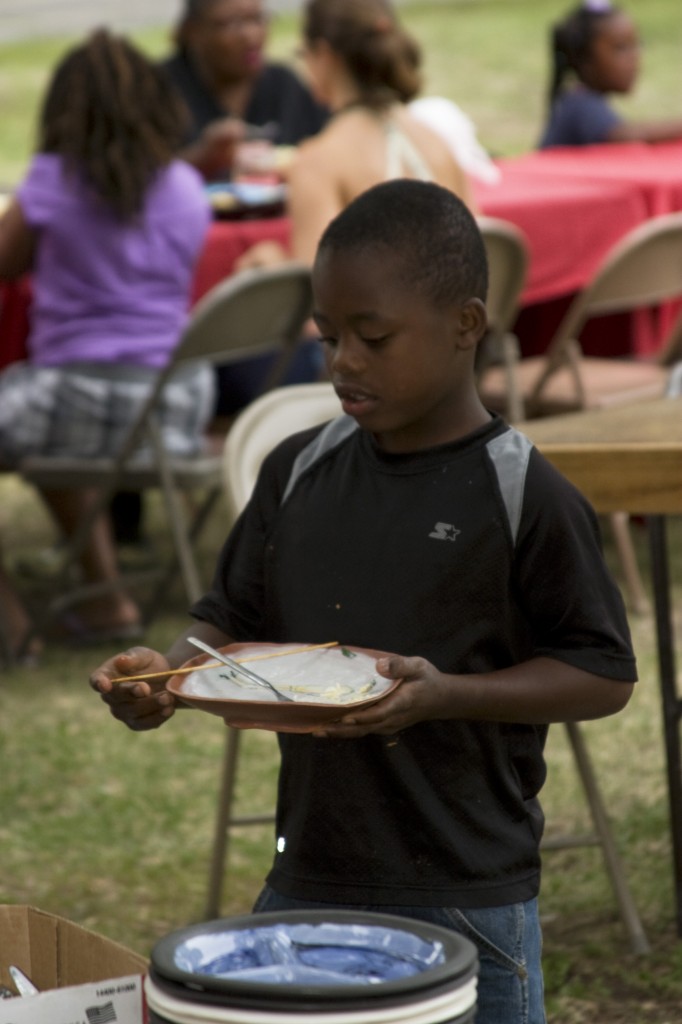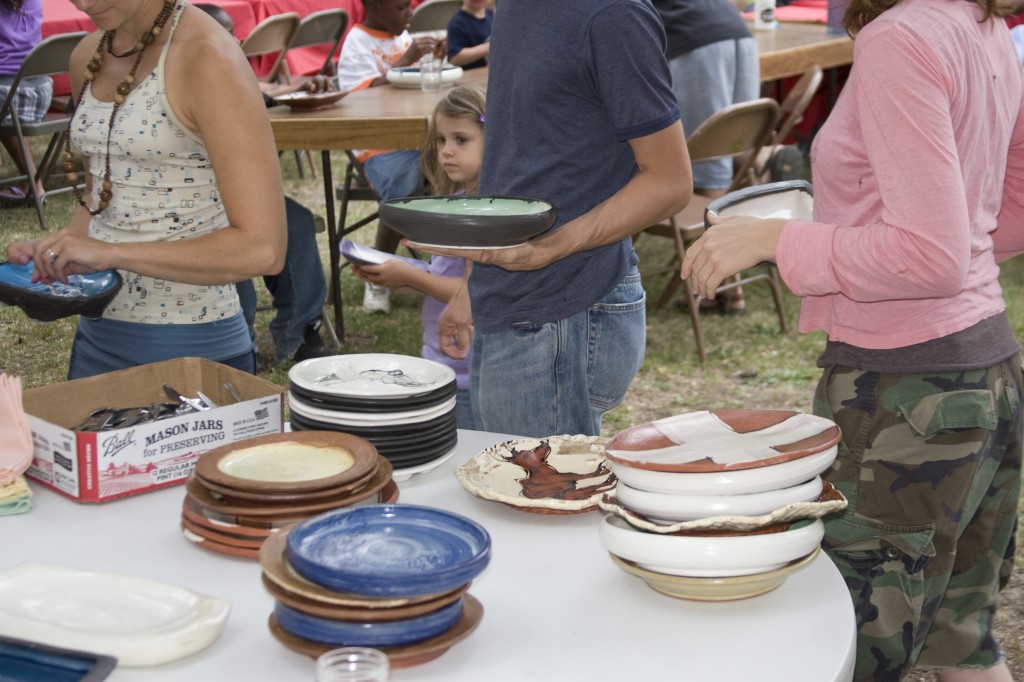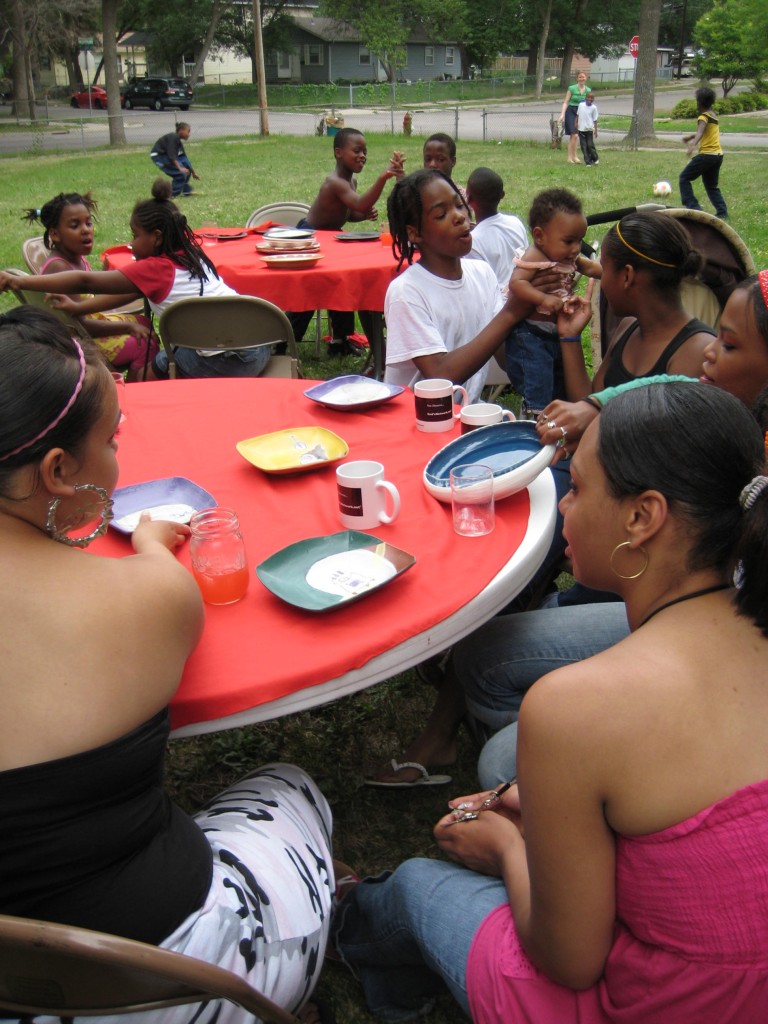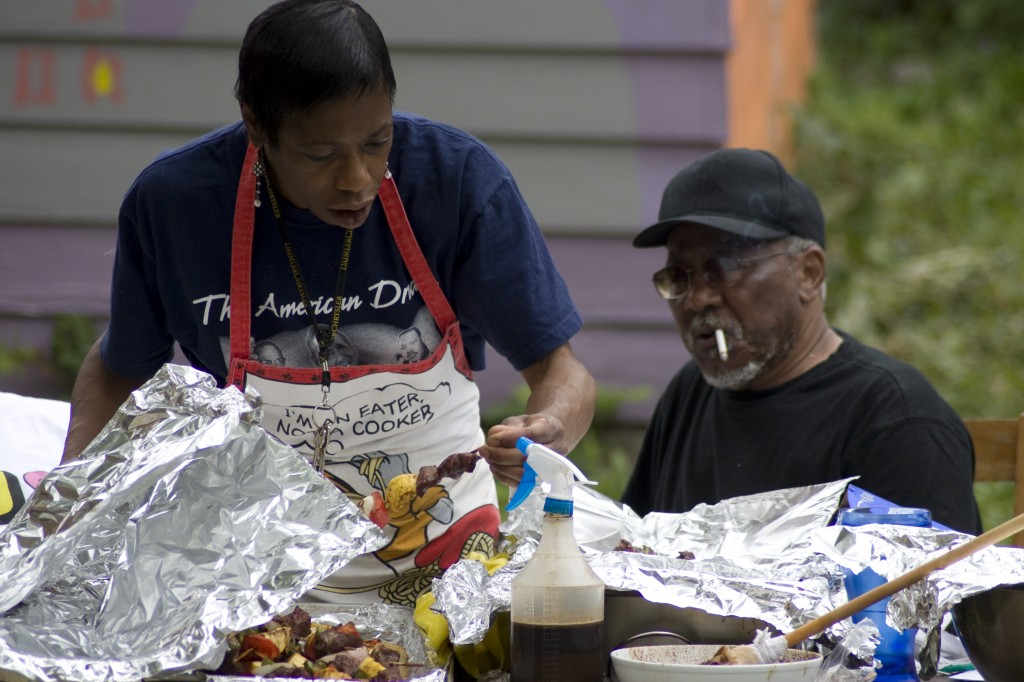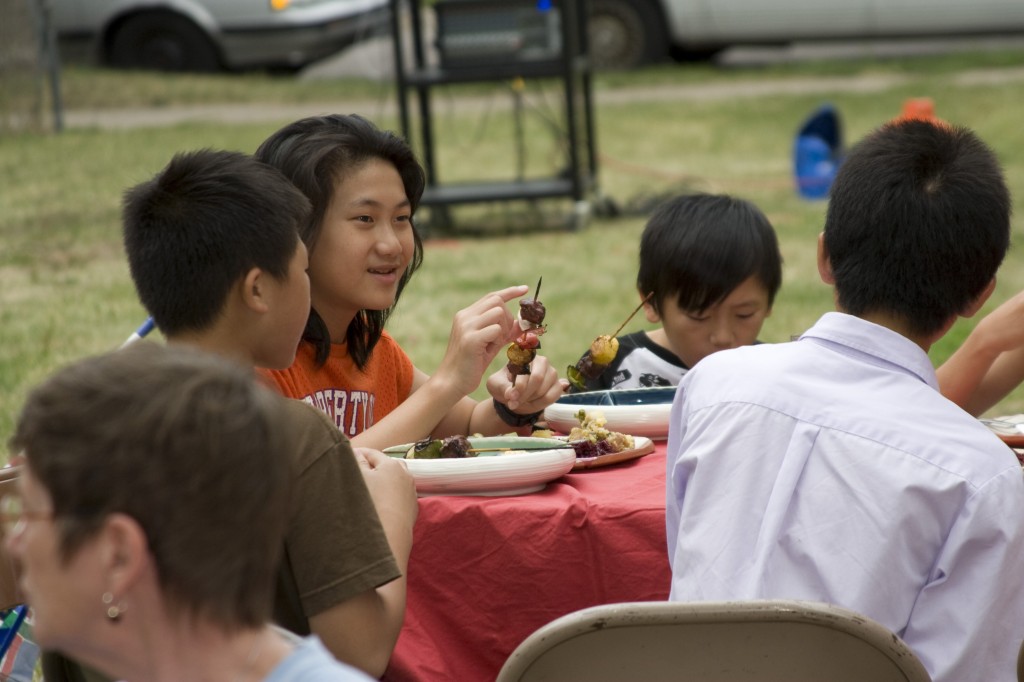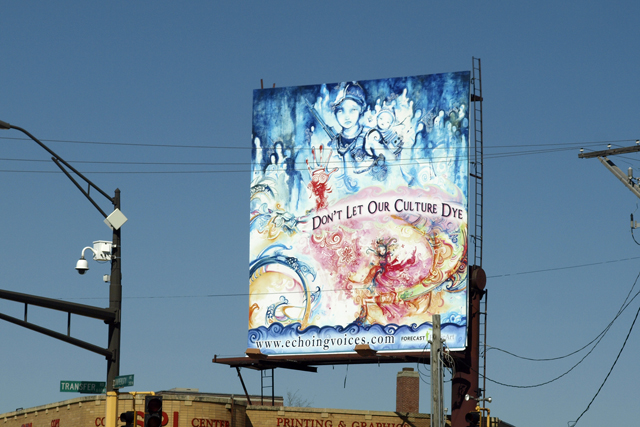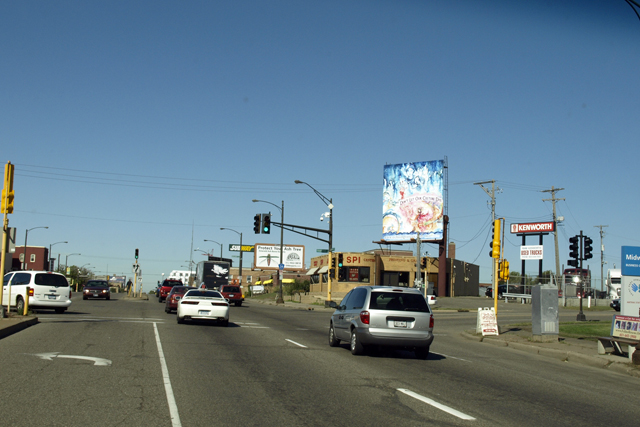2009 Forecast grantees Grace Davitt + Anna Metcalfe collaborated with Redeemer Lutheran Church + Redeemer Center for Life to host weekly outdoor dinners with one of a kind handmade ceramic tableware. At the last dinner participants were invited to take the dinnerware home with them to keep memories of the warm summer nights alive through the winter. Karis Thompson shares impressions of the event.
“A perfect summer evening for a meal outdoors. Tables draped with linen and set with handmade ceramic dishware, each uniquely designed and glazed. A menu showcasing locally raised meats and the harvest of urban gardens prepared collaboratively by seasoned and emerging chefs. Music inspiring conversation and movement. Neighbors and friends from near and far eating together, talking together – the meal and conversation extending well past the typical 20-30 minutes usually allocated for dining and ending only when all the food has been eaten or the sun begins to set.
How does this happen? And how did this happen in the Harrison neighborhood of North Minneapolis, a community whose median income and lack of whole foods offerings too often force a diet of affordable, accessible processed and fast foods?
It happened through the power of people and their connections and collaboration. Through Grace and Anna who wanted to explore the synergies of community and art and slow food and invested much in the conceiving and realization of this Thursday Nights Out venture. Through the commitment of neighborhood community gardeners – organized by Harriet – who lent their particular gardening wisdom and hours of cultivation to produce a striking harvest from the garden in Redeemer’s backyard.  Through neighborhood and visiting chefs passionate about recipes and taste and nurturing family and friends. Through local farmers who raised meat and produce for our table. Through volunteers gathering to cook and set tables and host a meal and wash dishes and greet neighbors from early in the morning to late in the evening each Thursday. And through a community’s openness to new recipes, new ways of cooking and eating, new conversations and relationships, and collaborating through different ways of perceiving, communicating, interacting.
Thursday Nights Out gave us a taste of being and becoming a community nurtured by inspired food and the power of relationships.”
-Reflection by Karis Thompson
Juried Call for Outdoor Public Sculpture
The Stevens Point Sculpture Park is accepting submission of sculpture work for their first annual,three-year outdoor sculpture exhibition. A local jury will choose pieces for display from April 15, 2010 through April 15, 2013.
The Stevens Point Sculpture Park, located in Central Wisconsin, is a 20-acre, city-owned park with nearly a mile of forested trails that are used year-round by people of all ages for biking, skiing, running and walking. The Park offers a wide variety of trees and geographic features including a pond, wetland and forest. It is a zone 4 growing season (which includes cold winters and hot summers).
The Stevens Point Sculpture Park is committed to providing a welcoming and accessible outdoor venue for sculpture and arts exhibitions, activities, and educational programs by enhancing the cultural life of our community and surrounding region through a diverse program of education, collaboration and experimentation.
The Park is located close to elementary, middle and high schools, and the University of Wisconsin-Stevens Point. The Park’s trails connect to the Stevens Point Green Circle Trail, a nationally recognized 31-mile recreational corridor that encircles the Stevens Point Urban Area (1993 National Park Service Award).
Artist submissions that are selected will receive $750 for a three-year exhibition loan of their piece. Sculpture submissions need to be free standing; foundations or bases are not provided. Delivery, installation, and return of work are the artist’s responsibility (please note in artist’s statement if any special installation needs are expected).
A wide variety of work will be considered, including: site specific work, ephemeral and/or permanent work, work in a variety of scales, art with a performance component, etc. Materials must be appropriate for the environmental location. For more information about the park or visitation requests, please contact Otis McLennon at otism@artsportagecounty.org
Artists may submit up to five pieces for consideration. Submissions must include the following information for each piece submitted:
Artist Name; Address; Phone; Email
Title of piece; Dimensions; Materials/Media
Images – JPEG (1000 pixels on the long side), slides will also be accepted
Artist’s Statement (including any specific installation requirements)
Mail to:
Attn: SPSP Juried Call
Arts Alliance Portage County
PO Box 565
Stevens Point, WI 54481
Or email: otism@artsportagecounty.org
In your submission, please let us know how you heard about this call, to help us better communicate.
All submissions must be received by November 13, 2009.
Electronic and standard mail submissions are accepted.
Calendar:
November 13, 2009 – Submissions due
January 15, 2010 – Notification of works selected (by phone or email with follow-up contract in mail)
January 30, 2010 – Contracts returned by artists
April 15 – May 15, 2010 – Sculpture installations
June 12, 2010 – Park Grand Opening
Forecast Public Art is excited to announce its newest public art project on University Ave, Echoing Voices, a billboard installation by artist, Kao Lee Thao. With support from the Jerome Foundation, Forecast Public Art selected Thao from a pool of local applicants to create a design for a billboard at the intersection of University Avenue and Cleveland in St. Paul. Thao chose to use the public visibility of the project to create a visual dialog about a topic close to her life, the Hmong Secret War.
“I was one of the first Hmong children born in America, each year my birth is a constant reminder of those who were left behind and continue to fight for my freedom. My aspiration was to create a painted billboard that speaks out about the injustices of the remaining Hmong soldiers called Freedom Fighters from the “Secret War†during the Vietnam War.
Inspired by Hmong textiles and vibrant colors of my culture I divided the billboard representing the two worlds I live in. My spirit is still trapped in the Jungles of Laos and my soul is in America living out my dreams. I want to inspire young minds to pursue their passion, but remind us not to forget how we won our freedom to America. I hope someday we can end the “Secret War†and bring peace to those remaining in Laos still fighting…†– Kao Lee Thao,
The Echoing Voices and a companion website (www.echoingvoices.com) will be installed on Monday September 21, 2009 and will remain on view through November at the intersection of University Avenue and Cleveland in St. Paul, MN.
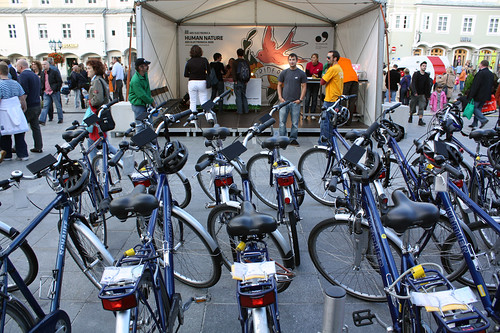
Blast Theory, RiderSpoke at Ars Electronica. Photo: Bruce Charlesworth
A highlight of the final days of Ars Electronica was Rider Spoke, a project by the UK-based collective Blast Theory. Mixing interactive media, installation, live performance, gaming and digital broadcasting, Blast Theory is perhaps best known for Kidnap, in which the winners of a lottery were abducted and held in a secret location for 48 hours. Rider Spoke extends the idea of the group’s search games Can You See Me Now? and Uncle Roy All Around You by asking each participant to ride a bicycle throughout a city after dark, with earphones and a handheld computer mounted on the handlebars.
I struck out away from the start point in the Hauptplatz and, as the sun was setting, pushed up a steep hill overlooking the Danube. While I cycled, melancholic music played and an earnest female voice asked me to reflect on a personal moment in my life and to find a unique “hiding place” where I could record a private response.
The computer screen functions as a positioning device that identifies available hiding places. It also alerts you to nearby source locations of recorded answers by other cyclists. These answers can only be heard on the spot where they were recorded, connecting you to the very recent reflections of anonymous participants. My time on the bike was limited to about an hour — probably due to the battery life of the device — and I came away wanting to be asked more questions and to explore more of the city. Rider Spoke allows for an engagement with the particular context of a city in potentially deep conceptual and emotional ways. My only critique of the system is that it did not pair the listener’s native language with the reflections of other participants speaking the same language.
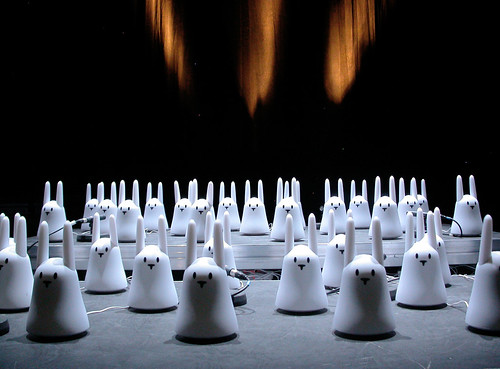
Antoine Schmitt and Jean-Jacques Birgé, NABAZ'MOB at Ars Electronica. Photo: Antoine Schmitt and Jean-Jacques Birgé
I can’t claim to have seen everything performative at the Festival, but did see most of the Pursuit of the Unheard program, comprised of performances by the Prix Ars Electronica Digital Musics prizewinners. NABAZ’MOB by Antoine Schmitt and Jean-Jacques Birga is an opera composed for 100 Wi-Fi equipped plastic bunnies that can be programmed to flash colored lights in their bellies, make twinkly music and swivel their ears. The music and choreography, transmitted via Wi-Fi and founded on repetition and time delay, appeared to be controlled by both the artists and the individual and collective rabbits. An earlier version on video of NABAZ’MOB can be seen here:
Other standouts were Tristan Perich’s Active Field for ten violins and ten-channel 1-bit music, performed by Perich and members of the Bruckner Orchester Linz and digitally-created, curtain-like visuals by Kenneth Huff accompanying Alan Hovhaness’ Lousadzak (Coming of Light). Bill Fontana’s Speeds of Time, a deconstruction of the sounds of Big Ben, was heard outdoors at Bruckner House (also as an installation across the river in the Pfarrkirche Urfahr). This arresting piece is a 12-hour multi-track recording made of a sound sculpture installed at Westminster, which derived from sensors and microphones attached to the clockwork mechanism and near the bells. A recording of Speeds of Time can be heard here.
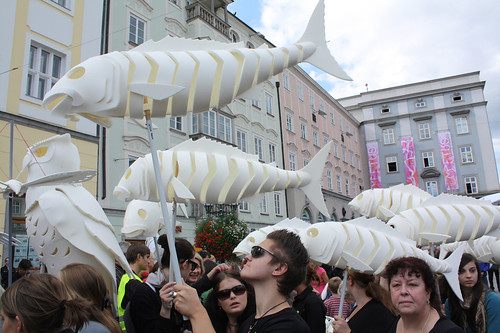
Flut Fish at Ars Electronica. Photo: Bruce Charlesworth
FLUT (Flood), mentioned in an earlier post, happened on September 5. The lead-in to the main performance was Die Prophezeiung (The Prophesy), during which performers and volunteers puppeted a seemingly endless array of animals made of white upholstery foam. For several hours in the afternoon, everything from snails to T-rexes milled through huge crowds in the Hauptplatz and nearby streets. The puppets were meticulously observed and crafted for shape and movement, and were entertaining to watch. The evening performance, Die Arche (The Ark), took place along the banks of the Danube. This part of FLUT was a mishmash of fireworks, browbeating orchestral music, declamatory videos, floating houses and icebergs. I couldn’t get into it.
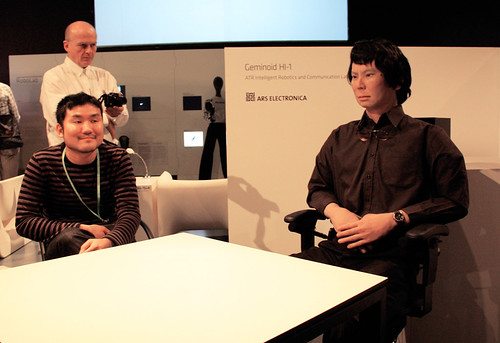
Hiroshi Ishiguro, Geminoid H1-1 at Ars Electronica. Photo: Bruce Charlesworth
Finally, I went to a demonstration of Geminoid HI-1 at the Ars Electronica Center. Hiroshi Ishiguro talked a bit about his creation, a sour-faced robot replica of himself that he uses to remotely give lectures in his stead at the University of Osaka. As Ishiguro went upstairs to sit at the control console, several of us in the small audience moved our chairs close to the table opposite Geminoid, in order to ask questions. Once activated, the robot looked around, its mouth opening and closing like a distressed fish. When someone observed that its rather intense facial expressions made it seem a bit frightening, the robot (Ishiguro on microphone) seemed surprised and a bit hurt. Hard questioning of Ishiguro’s goal to imitate human form and behavior were dodged, as was one query about a romantic scenario between two controllers of opposite-sex Geminoids.
— Bruce Charlesworth
Past Posts
Bruce Charlesworth at Ars Electronica
Ars Electronica.2
Ars Electronica.3
5 September 2009
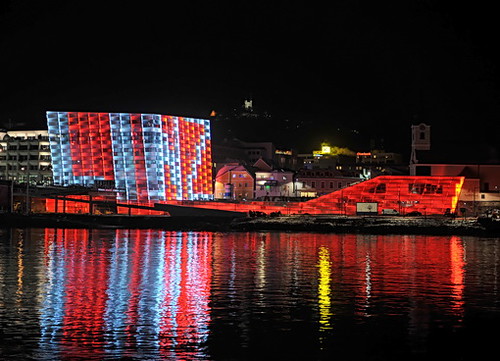
Ars Electronica Center on the bank of the Danube River. Photo: Courtesy City of Linz
It rained Friday in Linz, so it was a good day to go indoors. I headed for the new Ars Electronica Center for my longest visit so far. The glass and steel extension to the original building, designed by Treusch Architecture of Vienna, was opened earlier this year. Inside the building are extensive exhibition areas for contemporary and historical new media work. The Future Lab facilities contain laboratories and workshops for media art research, with offices and recreation rooms above. The main building also has a restaurant, bar and lecture rooms on its Sky Deck.
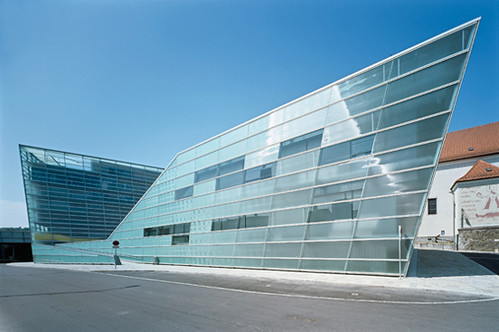
Ars Electronica Center. Photo: Rupert Steiner
The Ars Electronica Center has a sculptural presence. It is meant to be viewed at various distances from diverse vantage points and is easy to traverse on foot. Set alongside the Danube River, its shape evokes a cargo ship. The long prow serves as a public performance or gathering space with raked stairs for seating. The building’s overall grid of glass and its double facade give it a crystalline appearance.

Ars Electronica Center, Linz, Austria. Photo: Bruce Charlesworth
The glass exterior is part transparent and part translucent. At night, LED panels installed between the two layers of the facade illuminate the building. Each panel contains nine sets of four LEDs: red, green, blue and white. These are set vertically, one in each window, alternately facing left and right. Each window functions much like a pixel in a digital image and can be individually controlled to allow infinite variations in color, intensity and duration.
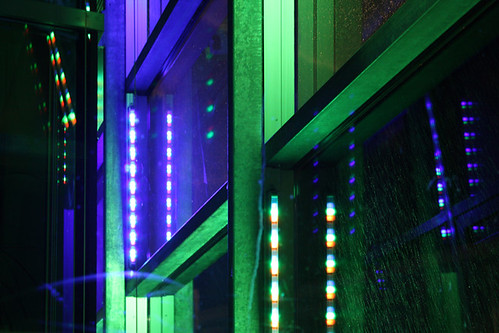
Ars Electronica Center, Linz, Austria. Photo: Bruce Charlesworth
I attended a lecture on the facade and learned that there are 40,000 LEDS, 2,000 meters of cable and 5,100 square meters of glass comprising 1,085 windows. An average window contains 36 LEDs. The building also has a powerful sound system.

Ars Electronica Center, Linz, Austria. Photo: Bruce Charlesworth
Both sound and lighting can be programmed to create unique artworks on the facade, utilizing blended color, patterns, text and imagery. 84 artists have already created programs for the building, only three of which were commissioned works. AEC makes proposing and designing for the building fairly easy. Artists can construct their work using a 3D rendering of the facade, available on the Center’s Future Lab website, without ever having to visit the site in Linz.
Here’s a test visualization of the building lighting done last year.
— Bruce Charlesworth
4 September 2009
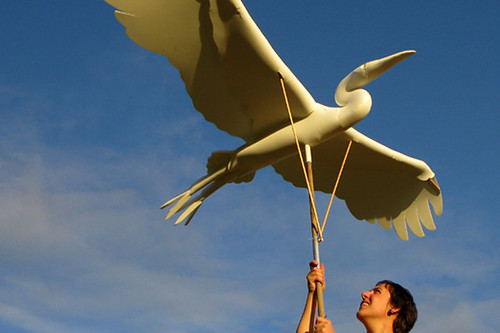
Photo: FLUT by Visualisierte Linzer Klangwoke.
Rain in Linz. Doesn’t bode well for some of the outside events today & tomorrow. These include Blast Theory’s Rider Spoke, a kind of wifi hide-and-seek for bicyclists equipped with handheld computers… and FLUT by Visualisierte Linzer Klangwoke, in which the city will be allegorically flooded and overrun with fantastic beasts. The allegory may turn literal if it keeps pouring.
Light sprinkles and overcast skies last night didn’t deter Sternennacht, during which lights were turned off in Hauptplatz (the central square in Linz) in order to better see the night sky. This is a great cooperative idea for a city. Unfortunately, stars were not visible, and any contemplative mood that might have resulted from the lack of light pollution was destroyed by what appeared to be the Austrian radio equivalent of Regis and Kathy Lee: an incessant happy chat session in a red-lighted tent.
On the other side of the square several people dressed in color-coded mime outfits were rotating and revolving in slow motion. I think they were supposed to be the planets, although there were more than eight (or nine, if you count Pluto). An older bearded guy in an orange jumpsuit and headlamp was clearly playing the Sun.

Photo: 80+1 building by Any-Time Architects
I revisited 80+1 Eine Weltreise/A Journey Around the World, housed in a striking mirrored structure nearby. Inside the wide opening of the 80+1 Base Camp are several networked pieces done over great distances. Included is a piece by the Chinese group 8GG interactive (Fu Yu, Jia Haiqing), in which air is “blown” from Beijing to Linz. Someone blowing into a recess in Beijing triggers a fan that conveys the smell of “spicy hotpot.” I wish this piece worked both ways, and the time distance makes for a sporadic experience. A more successful work, Digitie by Marianne Schmidt, allows you to insert your hand as someone at the Ars Electronica Center across the Danube does the same. Both hands are projected simultaneously. I was able to virtually stroke someone’s palm.
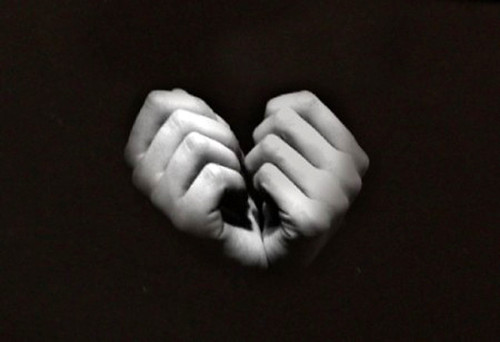
Photo: Digitie by Marianne Schultz
Another notable work in 80+1 is a photo-booth hookup to Bhutan, Grand Mutual Smiles by Australian Pierre Proske, based on the King of Bhutan’s pronouncement that “Gross National Happiness is more important than Gross National Product.” A Second Life setup seemed to be nothing more than SL as-is. I transported the very basic-looking default avatar to a popular English-speaking Welcome Area to see what would happen when other users got on the keyboard, but nothing more exciting ensued than physical collisions with avatars of Area regulars.
Additional information is available on 80+1‘s website,
Also in Hauptplatz is Japan Game in the Mobiles Oe1 Atelier, a white plastic geodesic dome. Inside are highlights from the Japan Media Arts Festival. Here you can try out a number of new Japanese game designs and witness for yourself how much contemporary media art utilizes the game paradigm.
— Bruce Charlesworth
[All this week, artist Bruce Charlesworth will be reporting from Ars Electronica.-SD]
3 Sept 2009
For me, events at Ars Electronica 2009 began last night with a presentation at the Lentos Kunstmuseum by multi-disciplinary American artist Tony Conrad. Best known for his 1966 film The Flicker (which I saw in its mind-bending 16mm entirety, back in grad school), Conrad appeared in conversation with Chris Salter and talked about his interest in the margins between picture and sound.
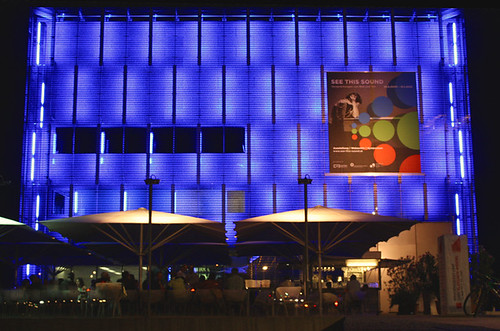
Lentos Kunstmuseum, Linz, Austria. Photo: Bruce Charlesworth
Conrad performed his Bowed Film, an instrument made from a length of film spliced into a kind of lasso. This he looped over his head, the long end tethered to the floor, and played with a violin bow. Normally this would be a private experience executed by one person and heard on headphones. Last night Conrad attached pickups to the instrument so that we could hear, too.
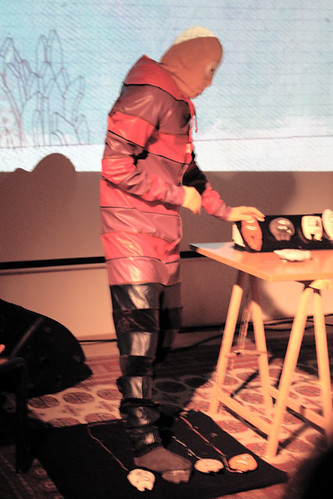
Ronnieism, performed by DJ Colette. Photo: Bruce Charlesworth
Later in the evening I went to the Grand Cafe zum Rothen Krebsen in Linz to see Ronnieism, performed by Ronnie Deelen. The small crowd was treated to a funhouse fusion of live-controlled music and video, composed on Gameboys and played on an instrument made of fifteen small stuffed toy animals.
Openings today in Linz include the new Ars Electronica Center, the CyberArts Exhibition at OK Offenes Kulturhaus and Human Nature at Brucknerhaus. More about these events tomorrow.
[updated 09.06.09]

The Bridge Homeless Assistance Center with public art by Gordon Huether receives an American Institute Of Architects (AIA) 2009 Housing Award.
The Bridge Homeless Assistance Center in Dallas, Texas was developed from a reclaimed industrial warehouse opened in May 2008.
It is a multi-purpose facility dedicated to serving homeless men, women and children, with a primary focus on the chronically homeless. The artist worked with the homeless to create seven art glass windows incorporating brightly colored mouth-blown glass, etched and silk-screened with text from writings of the shelter’s clients. The text is superimposed over the glass panels.
The Forth Plinth is a rotating public exhibition space in London. After sitting vacant for over 100 years the mayor of London took responsibility over Trafalgar Square in 1999 and created the Fourth Plinth Commissioning Group to select leading artists to create site specific work for the unused Plinth.
The current installation is by Antony Gormley famous for his use of the human form in gallery and public art installations.

View of Event Horizon part of Antony Gormley Blind Light at The Hayward. Photo copyright Gautier Deblonde
For Gormley’s Plinth installation he again reverts back to the human form but this time attempts to create a “living monument” in his project One and Other.
Every hour, 24 hours a day, for 100 days without a break, different people will make the Plinth their own. If you’re selected, you can use your time on the plinth as you like – to demonstrate, to perform, or simply to reflect. One & Other is open to anyone and everyone from any corner of the UK. As long as you’re 16 or over and are living, or staying, in the UK, you can apply to be part of this unforgettable artistic experiment. Participants will be picked at random, chosen from the thousands who will enter, to represent the entire population of the UK. The rules are simple: you must stand on the plinth alone, for the whole hour; you can do whatever you want, provided it’s legal; and you can take anything with you that you can carry.
via One & Other
But the best part of this website is the live webcam for those of us who want to experience the fun from afar!
The project will be “on view” until October 14th.

Schuykill Center for environmental education presents functional woodland shelters made from recycled and reused industrial materials as well as sustainable harvested bamboo. This is a really cool environmental exhibition for anyone interested in the environmental sustainable architecture or industrial design concepts. The projects presented were chosen from over 80 designs submitted by 65 teams from across the US and internationally. Check out the winning designs at http://www.schuykillcenter.org/gimmeshelter/
Centenarian Swiss artist Hans Erni created a 60-mitre-long ceramic tile mural entitled “Tu panta reiâ€, which adorns the security entrance of the United Nations building in Geneva, Switzerland.

